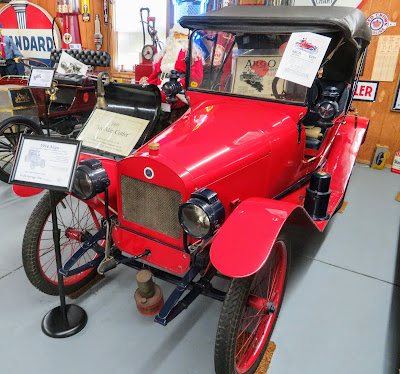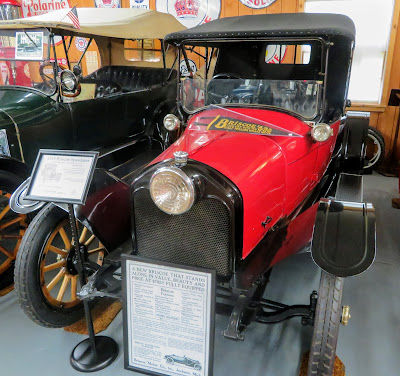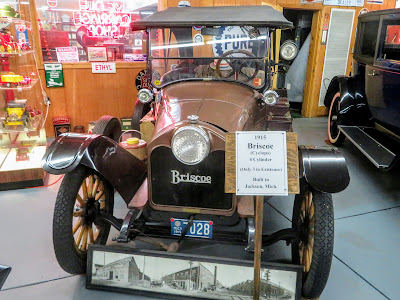Some time ago, when planning our trip to Michigan, I googled things to do and see in Jackson County. After all, it was the primary county where I was raised and where my mother lived until she passed in 1995. In addition, my father’s family is from Jackson County…
I thought
that I knew about all of the top attractions in the county so I was stunned
when I discovered a special museum focused on automotive history in a small
town just west of the city of Jackson and east of Concord, the latter being
where my mother’s last home was located.
This is Ye Ole Carriage Shop in Spring Arbor Michigan. The low-key appearing building doesn’t do justice to its contents. Michigan Hwy 60 is the main thoroughfare through Spring Arbor…but Ye Ole Carriage Shop is discretely located on an adjacent cross street in town, at 3538 Henderson Street. In addition, visits to the museum are limited to tours only. Visitors can’t just walk in and view the collection. Lloyd Ganton built the museum in 1974 but I’d never heard of it despite passing through Spring Arbor on a regular basis for many years.
A little information
about the ‘town’ of Spring Arbor is in order.
It is an unincorporated community and census-designated place in Jackson
County. Unlike many small towns and
villages across the USA, Spring Arbor is growing. Its 2020 population was 2,881, up over 27% in
just 10 years. Spring Arbor is the home
of Spring Arbor University, a liberal arts university that is affiliated with
the Free Methodist Church. With a
student body of about 1,400 students, the University is key to Spring Arbor’s
growth.
Although my focus was on the automobiles, Ye Ole Carriage Shop has much more to offer visitors. Our tour guide was Judi Ganton, Lloyd Ganton’s wife and partner in the world of collecting. The first thing we noted was a huge collection of Sparton products. This display is just a fraction of the Sparton items in the museum. Founded ca. 1900 and focused on making farm implement parts, the Withington Company hired William “Cap” Sparks and he soon became a partner. The company’s name eventually migrated to a combination of Sparks and Withington…aka “Sparton”.
In 1909
the Withington-Sparks Company began making radiator cooling fan assemblies and
horns for the auto industry. Then the
company created the first all-electric car horn and it was soon being used in
42 different auto models. The company
also manufactured the first all-electric car radios. Soon the Sparton Corporation was
manufacturing fans, radios, phonographs and much more, even early
televisions. By 1929, 1 out of every 15
workers in Jackson was employed by Sparton.
The company went out of business in 2009. To learn more about this innovative company,
go to https://www.mlive.com/news/jackson/2013/04/peek_through_time_jacksons_spa.html.
Lloyd Ganton loves automobiles, especially if they were built in Jackson Michigan! The automobile shown above is a 1903 Jaxon. Never heard of a Jaxon automobile? Neither had we!
Lloyd
graduated from Spring Arbor College and he settled in the area. Then he found a car that had been made in
Jackson. His new found passion led to a
consuming interest into cars made in Jackson and into the city’s auto
manufacturing history. His research
revealed that 24 different companies had built cars in the city and that, at
one time, auto manufacturing was the largest employer in town.
Lloyd
collects all types of autos but a main goal has been to add at least one of
every Jackson-made automobiles. He
currently has 18 Jackson-made autos. Of
the 6 he doesn’t have, 3 no longer exist and 3 are in collections which cannot
be purchased.
So what’s
the history of the Jaxon automobile? In
1894, Byron J. Carter went into a partnership with his father selling bicycles. By 1899 he’d built his first gasoline powered
automobile, but initially he focused on steam cars. His first steam cars were manufactured by the
Michigan Automobile Company in Kalamazoo Michigan. However by 1903, Carter had patented a
3-cylinder 6-horsepower steam engine and, with 2 partners, (one a buggy
manufacturer and the other who manufactured axles), the Jackson Automobile
Company was incorporated. Production of
the Jaxon model lasted only 1 year and this is the only remaining Jaxson in
existence. If you look closely, you can see that the Jaxon was steered via a tiller rather than a steering wheel.
This 2-seater runabout is a 1906 Steel Swallow. It is the only known Steel Swallow in existence. The Deering brothers from Spring Arbor Michigan and owners of the Steel Swallow Auto Company, built these autos in a facility in Jackson. Only about 50 of these cars were built. In 1906, you could buy a Steel Swallow for about $700. That was a lot of money when you consider the fact that the average worker only made between $200 and $400 a year.
In 2006, Mr.
Ganton recovered this auto from a barn in southern Michigan. It didn’t have a motor and the Swallow itself
was disassembled. He stored the car for
10 years until he found an original motor to match with it. The fully restored Steel Swallow with its
original air-cooled 4 HP Harley-Davidson engine was fully restored and put on
display in at Ye Ole Carriage Shop in 2019.
Now onto a brand name that still survives today. But these early Buicks were built in Jackson too. This is a 1907 Buick Model F. The Model F Buick was built in Jackson until 1907 when the company’s President, William C. Durant, the soon to be founder of General Motors, shifted production from Jackson to Flint Michigan.
Note: Prior to his successes with Buick, Durant
had made a fortune as co-owner of the Durant-Dort Carriage Company in Flint
Michigan. It was the largest carriage
manufacturer in the USA.
The Model
F was powered by a 2-cylinder engine, it had an 87 inch wheelbase and it
weighed 1,800 lbs. Back around the
beginning of the 1900s, many automobiles developed their reputation at the race
track, with hill climbs or by establishing land or endurance speed
records. When the Chicago American and
Examiner Newspaper stages a 1,000 mile relay race from Chicago to New York in
1906, the Buick Model F was the only competitor to complete the event. The Model F earned the nickname, ‘Old
Faithful’, often touted in company brochures, and it remained in production
through 1910.
This is a 1908 Fuller High Wheel. It is the only known High Wheel in existence. The Fuller was built by the Fuller Buggy Company in Jackson. The company made both high wheelers with a double chain drive as well as vehicles with pneumatic tires and a shaft drive. If you had wanted to buy a Fuller, they were priced from $800 to $1,200, not inexpensive for the time period.
The High
Wheel had a hand-cranked gasoline motor.
The high wheels were the same style as the wheels used on the Fuller
Buggy Company’s carriages. This style
was abandoned when it was discovered that these narrow wheels didn’t do well in
mud or soft soil. The owner of the
Fuller Buggy Company, George A. Mathews, also owned the Jackson Automobile
Company and the Fuller Company was absorbed into the larger operation in
1911.
This is a 1911 4-door Cutting automobile. It is powered with a 4 cylinder 40 HP engine. This unrestored original Cutting touring automobile is the only such model in existence. The Cutting autos were built in Jackson Michigan by the Clark-Carter Automobile Company from 1909 – 1911 and subsequently by the Cutting Motor Car Company from 1911 to 1912.
These
powerful automobiles featured a Milwaukee motor with horsepower ranging from 30
to 60 HP. They were priced at between
$1,200 and $1,500. Noted award winning early
race driver Bob Burman had worked as a ‘road tester’ for the Jackson Automobile
Company and in 1912 he drove a Cutting race car in the Indianapolis 500. Unfortunately, he crashed after 157 laps. The Cutting Motor Car Company failed in 1912
due to a lack of funding.
This little red 2-seater runabout really caught my eye… It’s a 1914 Argo, and yes, it is the only surviving Argo in existence! These small low-priced cars were built by the American Gear Company although I also found a reference to Benjamin Briscoe and the Briscoe Motors Company. Argos were powered by a 4 cylinder 12 HP engine and in an attempt to compete with the Ford Motor Company’s affordable Model-T, they were priced at between $250 and $500.
Production
of the Argo lasted less than 2 years, from 1914 to 1915. Englishman Mansell Hackett owned the Disco
Starter Company in Detroit and, as a related side business he would buy small
nearly bankrupt auto manufacturers, split them up and sell the parts or refurbish
them as a whole. One of Hackett’s
purchases was the Argo Motor Company as owned by Benjamin Briscoe. Hackett decided to keep this company and
begin manufacturing cars himself.
Reorganized as the Hackett Motor Car Company, this company operated from
1917 to 1919, manufacturing only about 118 autos…
Speaking of Benjamin Briscoe, his company, Briscoe Motor Corporation built these 2 rather unusual automobiles in Jackson. The first one shown above is a racy looking 4 cylinder Briscoe Speedster…one of only 2 in existence. The second photo is of a 1915 Briscoe Cyclops, a 4 seater meant for families. Only 3 of this Briscoe model have been found.
The
unusual feature on both cars is the cyclops, a single center mounted headlight. The headlight is actually faired into the
radiator shell. It turned out to be
quite unpopular and it was illegal in several states. Ben Briscoe claimed that this design came
directly from a French design studio.
This is a 1916 Briscoe. Note the absence of the cyclops headlight. While the Briscoe Motor Corporation was headquartered in New York City, the manufacturing plant was located in Jackson Michigan. I love the advertising accompanying this Briscoe Model. It was promoted as “a car for men and women”. Interestingly, in 1914 and 1915, Briscoe Motors began offering a 4-cylinder model with a lightweight body made of a composition paper-mache material.
At one
point, the Briscoe Motor Corporation was one of the 20 largest auto makers in
the USA. However, in 1921 when the US
was in a deep recession, Briscoe sold his interest in the company and
permanently exited from the auto industry.
He didn’t suffer…starting a Canadian company refining crude oil with a
process he invented, plus he mined gold and other materials in Colorado. Later in life, he retired to a 3,000 acre
estate in Florida.
The photos above are of a 1922 unrestored Earl Cabriole…and also of a fully restored 1922 Earl Cabriole. Judi and Lloyd Ganton own 2 of these autos and there are only 2 of these vehicles in existence! Lloyd left one unrestored to show the difference and give visitors an opportunity to understand the work restoration requires. FYI, trying to find a clear definition of cabriole is challenging at best…but as promoted in advertising by Earl Motors Incorporated, it refers to the convertible nature of this model’s roof...
At this
point I have realized that the early automotive industry was quite incestuous…with
one company or owner merging or buying out another after working for the
company. Benjamin Briscoe appointed
Clarence A. Earl as President of Briscoe Motor Corporation in the spring of
1921. Earl had previously served as a
Vice President of Willys-Overland in Toledo Ohio and has the distinction of
being fired by Walter P. Chrysler when he took over the helm at
Willys-Overland. To get a full picture
of Clarence Earl’s convoluted journey in the auto industry, just go to http://www.secondchancegarage.com/public4/earl-1.cfm.
Basically,
the Earl was manufactured in Jackson from 1920 – 1923. It was a longer more powerful version of the
Briscoe. It offered both open and closed
models with a 4-cylinder engine. An
advertisement for the 1922 Earle Cabriole touted all of the extras that came
with the car. For only $1,395 customers received
a touring trunk with a cover, 2 suitcases, a hat box, a bumper, motometer (a
radiator temperature gauge), sun visor, a 1-piece windshield with a wiper and a
Sparton horn! In total, less than 2,000
Earl Automobiles were built before the company closed shop. Clarence Earl had already moved on to the
Presidency of yet another automotive manufacturer…but that’s another story.
Note: I was gobsmacked when I came across a
listing of all of the automobile brand names that have ever been built in
Michigan. In the early days of auto
manufacturing, it was a lot like the Wild West!
Go to: https://en.wikipedia.org/wiki/Category:Motor_vehicle_manufacturers_based_in_Michigan.
I
have just scratched the surface as regards the automobiles and other
fascinating collectables on display at Ye Ole Carriage Shop. More will follow in my next post… Lloyd and
Judi Ganton have assembled an amazing personal collection!
Just
click on any of the photos to enlarge them…
Thanks
for stopping by for a visit!
Take
Care, Big Daddy Dave














Just a big WOW! So many cars, such a rich history! You've made it possible for me to visit the museum right here on my screen. I never knew that all those cars existed, though I did have a hint there had been hundreds of manufacturers to send people down the road.
ReplyDeleteWhat a great collection of vintage cars!
ReplyDeleteCars sure have changed since the early days but then again so have we.
ReplyDelete